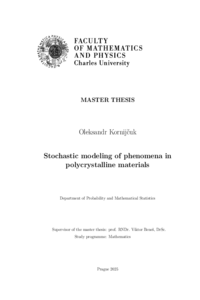Stochastické modelování dějů v polykrystalických materiálech
Stochastické modelování dějů v polykrystalických materiálech
diploma thesis (DEFENDED)

View/
Permanent link
http://hdl.handle.net/20.500.11956/199852Identifiers
Study Information System: 250228
Collections
- Kvalifikační práce [11466]
Author
Advisor
Consultant
Heller, Luděk
Referee
Pawlas, Zbyněk
Faculty / Institute
Faculty of Mathematics and Physics
Discipline
Probability, Mathematical Statistics and Econometrics with specialisation in Theory of Probability
Department
Department of Probability and Mathematical Statistics
Date of defense
11. 6. 2025
Publisher
Univerzita Karlova, Matematicko-fyzikální fakultaLanguage
English
Grade
Excellent
Keywords (Czech)
Laguerrova mozaika|krystalografické orientace|dvojčatěníKeywords (English)
Laguerre tessellation|crystallographic orientations|twinningTato diplomová práce zkoumá stochastický simulační model pro deformace v poly- krystalických materiálech se zrny s náhodnými orientacemi. Struktura zrn je modelována pomocí Laguerrových mozaik, což umožňuje kontrolu objemu buněk. Zaměřujeme se na deformace dvojčatěním, kdy se ve zrnách pod stresem vytvářejí lamelární struktury. Nej- prve představíme numerický rámec pro modelování růstu lamel, který respektuje ma- teriálová omezení na jejich pozici a objem. Poté zkoumáme napětí a deformaci během náhodného formování lamel pomocí numerického řešení na mozaikové síti pro parciální diferenciální rovnici. Jeho statistická analýza poskytuje vhled do dvojčatění v polykrys- talech a zlepšuje simulace pro predikci chování materiálu při zatížení.
This thesis explores a stochastic simulation model for deformation in polycrystalline materials with grains of random orientation. Grain structures are modeled using Laguerre tessellations, allowing cell volume control. We focus on deformation twinning where lamel- lar structures form within grains under stress. First, we introduce a numerical framework for modeling lamellar growth, respecting material-based constraints on their position and volume. Then, we examine stress and strain during random lamellar formation using a numerical solution on a tessellated mesh to a partial differential equation. Its statistical analysis offers insights into polycrystal twinning and improves simulations for predicting material behavior under load.
